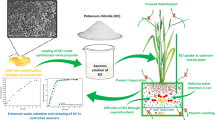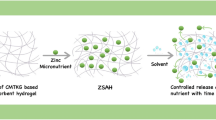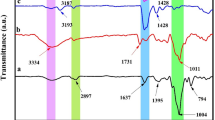Abstract
A crosslinked interpenetrating network based on gum xanthan was produced in the presence of gamma radiation and its potential as controlled release fertilizer was evaluated. Different process parameters such as gamma radiation dose, solvent amount, crosslinker and monomer concentrations were optimized to determine the maximum fluid uptake capacity of the synthesized sample. The samples were characterized using FTIR, XRD and SEM. The thermal stability was investigated using TGA, DTG and DTA techniques. The biofertilizer extracted from vermicompost was used as model agro-chemical and the presence of essential macro- and micronutrients in the biofertilizer was confirmed by chemical analysis. The in vitro release kinetics was administered by Korsmeyer–Peppas model. Release exponents were found in the range of 0.8–0.9, signifying the non-Fickian mode of diffusion where the relaxation of polymer matrix also played an important role. Further, the impact of biofertilizer control release on Cicer arietinum plant growth was investigated and it was found that there was an increase in stem and root bio-mass. The synthesized candidate polymer was found to act as a mini-water reservoir in different soil types and prolonged soil moisture for more than 50 days. Therefore, the synthesized superabsorbent with controlled release of biofertilizer can protect the environment from adverse effects of carcinogenic synthetic fertilizer leaching, along with its functionality to act as water reservoir in the fields.










Similar content being viewed by others
References
Welch R, Graham RD (1999) A new paradigm for world agriculture: meeting human needs: productive, sustainable, nutritious. Field Crop Res 60:1–10
Pinstrup-Andersen P, Hazell PBR (1985) The impact of the green revolution and prospects for the future. Food Rev Int 1:1–25
Davidson D, Gu FX (2012) Materials for sustained and controlled release of nutrients and molecules to support plant growth. J Agric Food Chem 60:870–876
Yang X, Wu X, Hao H, He Z (2008) Mechanisms and assessment of water eutrophication. J Zhejiang Univ Sci B 9:197–209
Di HJ, Cameron KC (2002) Nitrate leaching in temperate agroecosystems: sources, factors and mitigating strategies. Nutr Cycl Agroecosy 64:237–256
Brunelle T, Dumas P, Souty F, Dorin B, Nadaud F (2015) Evaluating the impact of rising fertilizer prices on crop yields. Agric Econ 46:653–666
Adhikary S (2012) Vermicompost, the story of organic gold: a review. Agric Sci 3:905–917
Chang C, Duan B, Cai J, Zhang L (2010) Superabsorbent hydrogels based on cellulose for smart swelling and controllable delivery. Eur Polym J 46:92–100
Muta H, Miwa M, Satoh M (2001) Ion-specific swelling of hydrophilic polymer gels. Polymer 42:6313–6316
Buenger D, Topuz F, Groll J (2012) Hydrogels in sensing applications. Prog Polym Sci 37:1678–1719
Zhang Y, Tao L, Li S, Wei Y (2011) Synthesis of multi-responsive and dynamic chitosan-based hydrogels for controlled release of bioactive molecules. Biomacromol 12:2894–2901
Kharkar PM, Kiick KL, Kloxin AM (2013) Designing degradable hydrogels for orthogonal control of cell microenvironments. Chem Soc Rev 42:7335–7372
Hoffman AS (2002) Hydrogels for biomedical applications. Adv Drug Deliver Rev 54:3–12
Wang JQ, Satoh M (2010) A novel reversible thermo-swelling hydrogel. Express Polym Lett 4:450–454
Ha W, Yu J, Song XY, Chen J, Shi YP (2014) Tunable temperature-responsive supramolecular hydrogels formed by prodrugs as a codelivery system. ACS Appl Mater Interfaces 6:10623–10630
Kulkarni AR, Soppimath KS (2000) Urea-formaldehyde nanocapsules for the controlled release of diclofenac sodium. J Microencapsul 17:449–458
Dragan ES (2014) Design and applications of interpenetrating polymer network hydrogels. A review. Chem Eng J 243:572–590
Kulkarni AR, Soppimath KS, Aminabhavi TM, Rudzinski WE (2001) In-vitro release kinetics of cefadroxil-loaded sodium alginate interpenetrating network beads. Eur J Pharm Biopharm 51:127–133
Soppimath KS, Kulkarni AR, Aminabhavi TM (2000) Controlled release of antihypertensive drug from the interpenetrating network poly(vinyl alcohol)–guar gum hydrogel microspheres. J Biomater Sci 11:27–43
Liu TY, Chen SY, Lin Yi-Ling, Liu DM (2006) Synthesis and characterization of amphiphatic carboxymethyl-hexanoyl chitosan hydrogel: water-retention ability and drug encapsulation. Langmuir 22:9740–9745
Demitri C, Scalera F, Madaghiele M, Sannino A, Maffezzoli A (2013) Potential of cellulose-based superabsorbent hydrogels as water reservoir in agriculture. Int J Polym Sci 2013:1–6
Zhong K, Lin ZT, Zheng XL, Jiang GB, Fang YS, Mao XY, Liao ZW (2013) Starch derivative-based superabsorbent with integration of water-retaining and controlled-release fertilizers. Carbohydr Polym 92:1367–1376
Abedi-Koupai J, Sohrab F, Swarbrick G (2008) Evaluation of hydrogel application on soil water retention characteristics. J Plant Nutr 31:317–331
Liang R, Yuan H, Xi G, Zhou Q (2009) Synthesis of wheat straw-g-poly(acrylic acid) superabsorbent composites and release of urea from it. Carbohydr Polym 77:181–187
Abd El-Mohdy HL (2007) Water sorption behavior of CMC/PAM hydrogels prepared by γ-irradiation and release of potassium nitrate as agrochemical. React Funct Polym 67:1094–1102
Kulkarni AR, Soppimath KS, Aminabhavi TM, Daveb AM, Mehta MH (2000) Glutaradehyde crosslinked sodium alginate beads containing liquid pesticide for soil application. J Control Release 63:97–105
Kulkarni AR, Soppimath KS, Aminabhavi TM (1999) Controlled release of diclofenac sodium from sodium alginate beads crosslinked with glutaraldehyde. Pharm Acta Helv 74:29–36
Nath G, Singh K (2009) Utilization of vermiwash potential on certain summer vegetable crops. J Cent Eur Agr 10:417–426
Jamnongkan T, Kaewpirom S (2010) Potassium release kinetics and water retention of controlled-release fertilizers based on chitosan hydrogels. J Polym Environ 18:413–421
Guilherme MR, Aouada FA, Fajardo AR, Martins AF, Paulino AT, Davi MFT, Rubira AF, Muniz EC (2015) Superabsorbent hydrogels based on polysaccharides for application in agriculture as soil conditioner and nutrient carrier: a review. Eur Polym J 72:365–385
Singh B, Sharma V (2017) Crosslinking of poly(vinylpyrrolidone)/acrylic acid with tragacanth gum for hydrogels formation for use in drug delivery applications. Carbohydr Polym 157:185–195
Ritger PL, Peppas NA (1987) A simple equation for description of solute release I. Fickian and non-Fickian release from non-swellable devices in the form of slabs, spheres, cylinders or discs. J Control Release 5:23–36
Singh B, Sharma N, Chauhan N (2007) Synthesis, characterization and swelling studies of pH responsive psyllium and methacrylamide based hydrogels for the use in colon specific drug delivery. Carbohydr Polym 69:631–643
Kumbar SG, Kulkarni AR, Dave AM, Aminabhavi TM (2001) Encapsulation efficiency and release kinetics of solid and liquid pesticides through urea formaldehyde crosslinked starch, guar gum, and starch/guar gum matrices. J Appl Polym Sci 82:2863–2866
Kulkarni AR, Soppimath KS, Aminabhavi TM, Dave AM, Mehta MH (1999) Urea–formaldehyde crosslinked starch and guar gum matrices for encapsulation of natural liquid pesticide [Azadirachta Indica A. Juss. (neem) seed oil]: swelling and release kinetics. Appl Polym Sci 73:2437–2446
Ladizinsky G, Adler A (1976) The origin of chickpea Cicer arietinum. Euphytica 25:211–217
Sharma K, Kaith BS, Kumar V, Kalia S, Kumar V, Swart HC (2014) Water retention and dye adsorption behavior of Gg-cl-poly(acrylic acid-aniline) based conductive hydrogels. Geoderma 232:45–55
Bardajee GR, Pourjavadi A, Soleyman R, Sheikh N (2008) Irradiation mediated synthesis of a superabsorbent hydrogel network based on polyacrylamide grafted onto salep. Nucl Instr Methods Phys Res B 266:3932–3938
El-Din HMN, El-Naggar AWM (2010) Gamma radiation synthesis and swelling properties of hydrogels based on poly(ethylene glycol)/methacrylic acid (MAc) mixtures. J Appl Polym Sci 117:1137–1143
Pourjavadi A, Barzegar SH, Mahdavinia GR (2006) MBA-crosslinked Na–Alg/CMC as a smart full-polysaccharide superabsorbent hydrogels. Carbohydr Polym 66:386–395
Mahdavinia GR, Pourjavadi A, Hosseizadeh H, Zohuriaan MJ (2004) Modified chitosan 4. Superabsorbent hydrogels from poly(acrylicacid-co-acrylamide) grafted chitosan with salt- and pH-responsiveness properties. Eur Polym J 40:1399–1407
Mundargi RC, Patil SA, Aminabhavi TM (2007) Evaluation of acrylamide-grafted-xanthan gum copolymer matrix tablets for oral controlled delivery of antihypertensive drugs. Carbohydr Polym 69:130–141
Amin MCIM, Ahmad N, Pandey M, Xin CJ (2014) Stimuli-responsive bacterial cellulose-g-poly(acrylic acid-co-acrylamide) hydrogels for oral controlled release drug delivery. Drug Dev Ind Pharm 40:1340–1349
Kaith BS, Sharma K, Kumar V, Kalia S, Swart HC (2014) Fabrication and characterization of gum ghatti-polymethacrylic acid based electrically conductive hydrogels. Synthetic Met 187:61–67
Malik H, Gupta N, Sarkar A (2002) Anisotropic electrical conduction in gum arabica—a biopolymer. Mater Sci Eng C 20:215–218
Sukriti Sharma J, Pruthi V, Anand P, Chaddha APS, Bhatia J, Kaith BS (2016) Surface response methodology–central composite design screening for the fabrication of a Gx-psy-g-polyacrylicacid adsorbent and sequestration of auramine-O dye from a textile effluent. RSC Adv 6:74300–74313
Parikh A, Madamwar D (2006) Partial characterization of extracellular polysaccharides from cyanobacteria. Bioresour Technol 97:1822–1827
Sharma J, Sukriti, Kaith BS, Bhatti MS (2017) Fabrication of biodegradable superabsorbent using RSM design for controlled release of KNO3. J Polym Environ 1–14. doi:10.1007/s10924-017-0959-8
Singh B, Sharma V (2014) Correlation study of structural parameters of bioadhesive polymers in designing a tunable drug delivery system. Langmuir 30:8580–8591
Spaink HP (2000) Root nodulation and infection factors produced by rhizobial bacteria. Annu Rev Microbiol 54:257–288
Acknowledgements
One of the authors is extremely thankful to MHRD, New Delhi for providing fellowship for carrying out this research work. The author is also thankful to Instrumentation Center, IIT Roorkee, for characterization of the samples.
Author information
Authors and Affiliations
Corresponding author
Rights and permissions
About this article
Cite this article
Sukriti, Kaith, B.S. & Jindal, R. Controlled biofertilizer release kinetics and moisture retention in gum xanthan-based IPN. Iran Polym J 26, 563–577 (2017). https://doi.org/10.1007/s13726-017-0539-8
Received:
Accepted:
Published:
Issue Date:
DOI: https://doi.org/10.1007/s13726-017-0539-8




